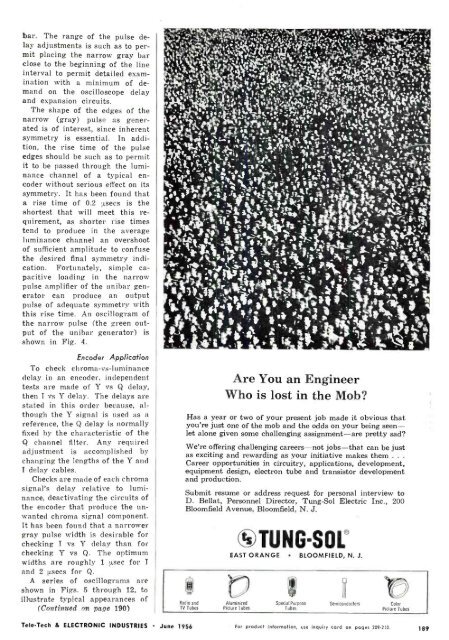TELE-TECH & - AmericanRadioHistory.Com
TELE-TECH & - AmericanRadioHistory.Com
TELE-TECH & - AmericanRadioHistory.Com
You also want an ePaper? Increase the reach of your titles
YUMPU automatically turns print PDFs into web optimized ePapers that Google loves.
ar. The range of the pulse delay<br />
adjustments is such as to permit<br />
placing the narrow gray bar<br />
close to the beginning of the line<br />
interval to permit detailed examination<br />
with a minimum of demand<br />
on the oscilloscope delay<br />
and expansion circuits.<br />
The shape of the edges of the<br />
narrow (gray) pulse as generated<br />
is of interest, since inherent<br />
symmetry is essential. In addition,<br />
the rise time of the pulse<br />
edges should be such as to permit<br />
it to be passed through the luminance<br />
channel of a typical encoder<br />
without serious effect on its<br />
symmetry. It has been found that<br />
a rise time of 0.2 secs is the<br />
shortest that will meet this requirement,<br />
as shorter rise times<br />
tend to produce in the average<br />
luminance channel an overshoot<br />
of sufficient amplitude to confuse<br />
the desired final symmetry indication.<br />
Fortunately, simple capacitive<br />
loading in the narrow<br />
pulse amplifier of the unibar generator<br />
can produce an output<br />
pulse of adequate symmetry with<br />
this rise time. An oscillogram of<br />
the narrow pulse (the green output<br />
of the unibar generator) is<br />
shown in Fig. 4.<br />
Encoder Application<br />
To check chroma -vs- luminance<br />
delay in an encoder, independent<br />
tests are made of Y vs Q delay,<br />
then I vs Y delay. The delays are<br />
stated in this order because, although<br />
the Y signal is used as a<br />
reference, the Q delay is normally<br />
fixed by the characteristic of the<br />
Q channel filter. Any required<br />
adjustment is accomplished by<br />
changing the lengths of the Y and<br />
I delay cables.<br />
Checks are made of each chroma<br />
signal's delay relative to luminance,<br />
deactivating the circuits of<br />
the encoder that produce the unwanted<br />
chroma signal component.<br />
It has been found that a narrower<br />
gray pulse width is desirable for<br />
checking I vs Y delay than for<br />
checking Y vs Q. The optimum<br />
widths are roughly 1 sec for I<br />
and 2 µsecs for Q.<br />
series of oscillograms are<br />
A<br />
shown in Figs. 5 through 12, to<br />
illustrate typical appearances of<br />
(Continued on page 190)<br />
Are You an Engineer<br />
Who is lost in the Mob?<br />
Has a year or two of your present job made it obvious that<br />
you're just one of the mob and the odds on your being seen -<br />
let alone given some challenging assignment -are pretty sad?<br />
We're offering challenging careers -not jobs -that can be just<br />
as exciting and rewarding as your initiative makes them .. -<br />
Career opportunities in circuitry, applications, development,<br />
equipment design, electron tube and transistor development<br />
and production.<br />
Submit resume or address request for personal interview to<br />
D. Bellat, Personnel Director, Tung -Sol Electric Inc., 200<br />
Bloomfield Avenue, Bloomfield, N. J.<br />
Radio and<br />
TV Tubes<br />
®TUNG -SOS<br />
EAST ORANGE BLOOMFIELD, N. J.<br />
Aluminised Special Purpose Semiconductors<br />
Picture Tubes<br />
Tubes<br />
Color<br />
Picture Tubes<br />
Tele -Tech & ELECTRONIC INDUSTRIES June 1956 For product information, use inquiry card on pages 209 -210.<br />
189
















